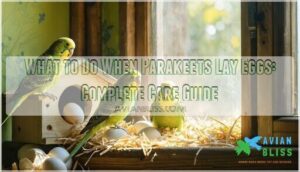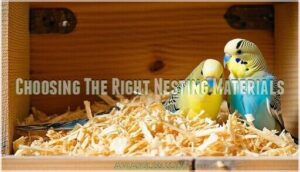This site is supported by our readers. We may earn a commission, at no cost to you, if you purchase through links.
 When your parakeets lay eggs, you’ll need to set up a proper nest box that’s 6-8 inches in diameter with natural materials like aspen shavings or paper bedding. Position the nest box away from drafts and noise in a quiet area.
When your parakeets lay eggs, you’ll need to set up a proper nest box that’s 6-8 inches in diameter with natural materials like aspen shavings or paper bedding. Position the nest box away from drafts and noise in a quiet area.
Keep temperatures between 65-85°F and maintain 65% humidity during incubation. Don’t disturb the eggs—your parakeets are natural parents who know what they’re doing. Provide calcium-rich nutrition for the mother and avoid handling the eggs completely.
The key is creating a stress-free environment while letting nature take its course. Understanding the specific timing and warning signs can make all the difference in breeding success.
Table Of Contents
- Key Takeaways
- Preparing The Nesting Area
- Nutrition and Health
- Caring for The Eggs
- Managing The Environment
- Post-Incubation Care
- Frequently Asked Questions (FAQs)
- How do I Stop my parakeet from laying eggs?
- How to take care of parakeets?
- How do you care for parakeet eggs?
- Can parakeets stop laying eggs?
- When should you care for baby parakeets?
- How long does it take parakeets to lay eggs?
- How common is it for parakeets to lay unfertilized eggs?
- Do male parakeets play a role in incubating the eggs?
- What does it mean if my parakeet lays an egg and abandons it?
- How often do parakeets usually lay eggs?
- Conclusion
Key Takeaways
- Set up a 6-8 inch diameter nest box with natural materials like aspen shavings in a quiet, draft-free location away from disturbances and noise.
- Don’t handle or inspect the eggs during the 18-day incubation period—let your parakeets’ natural parenting instincts guide the process without interference.
- Provide calcium-rich nutrition with fortified pellets, crushed eggshells, and dark leafy greens like kale to support strong eggshell development and the mother’s health.
- Maintain temperatures between 65-85°F with 65% humidity while creating a stress-free environment through minimal noise and consistent routines.
Preparing The Nesting Area
You’ll need to create a proper nesting environment before your parakeet’s eggs arrive, which means setting up a secure 6-8 inch diameter nest box with clean, natural materials like shredded paper or coconut fibers.
Place this nest box in a quiet, draft-free location where your parakeets can incubate their eggs without constant disturbances that might cause them to abandon the clutch.
Providing a Safe and Comfortable Space
Your nesting-area setup is vital for breeding success. Creating the right environment means your parakeets will feel secure enough to lay eggs.
- Cage Size Requirements: Provide adequate space with a 6-8 inch diameter nesting box mounted securely inside the cage to prevent accidents.
- Temperature Control and Privacy Needs: Position the nesting box away from drafts and high-traffic areas, maintaining temperatures between 65-85°F while providing quiet corners for nesting security.
- Noise Reduction Strategies: Keep the nesting environment calm by placing the cage in peaceful areas, minimizing sudden sounds that could stress breeding pairs and disrupt natural behaviors.
Choosing The Right Nesting Materials
Once you’ve secured your nesting box, selecting proper nesting materials becomes your next priority. The only safe material is all natural Aspen shavings, though paper bedding sold at pet supply stores makes convenient, inexpensive, and sanitary nest box fillers.
These natural options provide the soft nesting texture parakeets need while ensuring material safety. Aromatic oils from other wood types can cause toxic reactions in parakeets.
Material durability matters since your birds will use this space for weeks, so choose materials that won’t break down easily or create dust.
Avoiding Disturbances During Incubation
With proper nesting materials in place, you’ll want to create incubation privacy for your breeding pair. During the 18-day incubation period, avoid nest inspections and minimize handling concerns that cause parental stress. Birds demonstrate complex nest building, so disturbances should be avoided.
- Keep noise reduction around the nesting area to prevent disrupting natural nesting behavior
- Limit light sensitivity by maintaining consistent lighting without sudden environmental changes
- Restrict unnecessary nest checks that can interrupt the delicate incubation process
Nutrition and Health
Your parakeet’s nutritional needs increase dramatically during egg-laying, requiring a calcium-rich diet with fortified pellets, crushed eggshells, and dark leafy greens like kale.
You’ll need to monitor your bird closely for signs of egg-binding, lethargy, or other health complications that can arise during this demanding reproductive period.
Ensuring a Balanced Diet Rich in Calcium
When your parakeets start laying eggs, calcium becomes their nutritional lifeline for strong eggshell development. You’ll need to offer calcium sources like kale, broccoli, and cuttlebone to support healthy chick development. Here’s what works best:
| Calcium Sources | Supplementation Options | Benefits for Eggshell Quality |
|---|---|---|
| Kale, broccoli | Cuttlebone, mineral blocks | Stronger shells |
| Almonds, dandelion greens | Crushed oyster shells | Better calcium absorption |
| Calcium-fortified pellets | UVB lighting for vitamin D3 | Reduced egg-binding risk |
| Fresh figs, chia seeds | Professional supplements | Optimal chick health |
Focus on dietary variety rather than single sources for the best nutritious diet outcomes. Ensuring adequate calcium intake levels is vital for preventing calcium deficiency in parakeets.
Supporting The Mother’s Health During Laying
Beyond calcium, you’ll need to support your parakeet’s overall health during egg-laying. Increase her nutritious diet with extra protein and vitamins to fuel egg production. Maintain constant access to fresh water for proper hydration importance.
Create stress reduction by maintaining quiet surroundings and consistent routines. Consider a parakeet’s vitamin needs during this vital time.
Schedule veterinary checkups if she seems lethargic or stops eating, as postpartum recovery requires careful monitoring.
Monitoring for Signs of Illness or Stress
While good nutrition boosts your hen’s health, watching for stress indicators and behavioral changes is equally important. Your parakeet can’t tell you she’s struggling, so you’ll need to spot trouble early.
Watch for these warning signs:
- Feather plucking – indicates anxiety or health issues
- Appetite loss – weakens her immune system when she needs strength most
- Breathing issues – labored breathing or tail bobbing signals serious problems
- Lethargy – unusual sluggishness or sitting at cage bottom
Contact an avian veterinarian immediately if you notice these symptoms. Your mother’s health depends on quick veterinary care.
Caring for The Eggs
Once your female parakeet starts laying eggs, you’ll need to resist the urge to check on them constantly, as frequent handling can stress the mother and damage the developing embryos.
Your main job is maintaining a clean environment around the nesting area while giving the parents complete privacy to handle the 18-day incubation period naturally.
Leaving The Eggs Alone During Incubation
Once your hen starts her incubation period, resist the urge to peek. Natural incubation works best when parental instincts guide the process without minimal interference.
Frequent nest inspections can cause your hen to abandon her eggs completely. Trust her natural ability—she knows exactly how to manage egg development during the incubation process.
Trust your hen’s instincts during incubation—frequent nest checks can cause complete egg abandonment
Avoid nest checks for ideal hatching success.
Maintaining a Clean and Hygienic Environment
While your parakeets incubate naturally, cage sanitation becomes your top priority. Remove droppings daily through waste removal and replace soiled nesting material weekly.
Use disinfecting supplies that are bird-safe on surrounding surfaces. Monitor for pest control issues and maintain fresh water hygiene.
Keep the nesting area spotless without disturbing the nest box during critical incubation periods.
Avoiding Handling The Eggs or Mother
Your hands-off approach ensures natural incubation success when parakeets lay eggs. Resist the urge to peek or touch during this sensitive period.
Here’s how to practice minimal intervention:
- Observe from distance – Watch the nesting area without disturbing the parents
- Skip unnecessary nest inspections – Check only if you notice obvious problems
- Avoid handling eggs – Your touch can damage developing embryos or cause abandonment
- Reduce maternal stress – Keep interactions to essential feeding and water changes
- Trust natural instincts – Parents know best for egg care
This observation technique protects against egg handling risks while maximizing hatching success. Moving them can risk mother abandonment issues.
Managing The Environment
You’ll need to control temperature, humidity, and noise levels to create the perfect environment for your parakeet’s eggs to develop successfully.
Maintaining temperatures between 65-85°F and keeping the area quiet reduces stress on both parents and developing chicks.
Regulating Temperature and Humidity
Your parakeet’s eggs need precise environmental control for successful incubation. Maintain an ideal temperature of 98.5-99.7°F using heat lamps or an incubator. Keep humidity levels at 65% during incubation, increasing to 70% three days before hatching eggs. Monitoring equipment like thermometers and hygrometers ensures accuracy. Consider using a specialized parakeet incubator for best results.
Consider seasonal adjustments and avoid temperature fluctuations exceeding 2°F, which can harm developing embryos.
| Parameter | Target Range | Equipment Needed |
|---|---|---|
| Temperature | 98.5-99.7°F | Heat lamp, thermometer |
| Humidity | 65% (70% pre-hatch) | Hygrometer, water dish |
| Ventilation | Adequate airflow | Fan, vents |
| Monitoring | Continuous | Digital gauges |
Minimizing Stress and Noise Levels
Beyond controlling temperature and humidity, your parakeets need a calm environment during this delicate time. Reduce external stimuli by establishing quiet hours around the nesting area. Your happy mom deserves peace while she focuses on her eggs. Consider sound dampening methods and make gradual changes to avoid startling her. A stimulating environment, however, is still important for her overall wellbeing, so be sure to provide essential toys and accessories.
Here are five ways to create tranquility around your nesting box:
- Move the cage away from high-traffic areas like hallways or kitchens
- Cover three sides of the cage with a soft blanket during peak activity hours
- Turn off televisions, radios, and loud appliances near the nesting environment
- Speak in whispers when approaching and avoid sudden movements
- Schedule household activities like vacuuming for times when you’re away
Ensuring Proper Ventilation and Air Quality
Fresh air circulation prevents ammonia buildup and airborne pathogens in your parakeet’s nesting area. Position the nesting box away from drafts while ensuring gentle airflow. Clean air filters regularly for dust control and mold prevention. Your bird’s nesting environment needs the same care as a nursery.
| Ventilation Factor | Ideal Condition | Warning Signs |
|---|---|---|
| Air Exchange | Gentle, consistent flow | Stale, musty odors |
| Filter Maintenance | Weekly cleaning | Visible dust accumulation |
| Humidity Control | 40-50% relative | Condensation on surfaces |
| Nesting Sites Position | Draft-free but ventilated | Birds avoiding area |
| Nesting Materials | Dry, mold-free | Damp, discolored bedding |
Post-Incubation Care
Once your parakeet chicks hatch after 18-22 days, you’ll need to shift focus from egg care to supporting both the exhausted mother and her vulnerable babies.
This critical period requires careful monitoring of the chicks’ development while ensuring the female parakeet recovers her strength through proper nutrition and minimal stress.
Preparing for Hatching and Chicks
After creating the right environment, hatching brings new excitement and responsibilities. Your hatchlings need immediate attention for healthy development.
- Chick Brooder Setup: Prepare a warm, escape-proof space maintaining 85-90°F for newborns.
- Hand-Feeding Formula: Stock age-appropriate nutrition for potential feeding assistance needs.
- Socializing Chicks: Plan gentle handling sessions to build human bonds during critical development periods.
Monitor hatch timing carefully—chicks emerge over several days, requiring individualized care as each baby develops at different rates.
Supporting The Mother’s Recovery
After the hatching marathon, your parakeet mother needs TLC like any new mom. Offer a calcium-rich diet with fortified pellets and leafy greens for calcium replenishment and feather health.
Provide quiet rest areas for recovery and emotional support. Monitor her postpartum nutrition closely—she’s burned serious energy! A nutritious diet helps restore the mother’s health after her remarkable nesting journey.
Monitoring The Health of The Chicks
After your hatchlings emerge, watch their chick growth rates closely through daily weighing and observation. Healthy babies show steady feather development, clear eyes, and active movement in the brooder box.
Schedule avian vet visits for early health assessments while beginning gentle early socialization.
Monitor the weaning process carefully, as proper chick care with your avian veterinarian’s guidance ensures strong development.
Frequently Asked Questions (FAQs)
How do I Stop my parakeet from laying eggs?
Like turning off a factory’s production line, you can discourage egg-laying by reducing daylight to 8-10 hours daily, removing nesting materials, and providing less protein-rich foods.
How to take care of parakeets?
You’ll need quality pellets, fresh water daily, and a clean cage. Provide mental stimulation with toys, social interaction, and regular vet checkups. Maintain proper temperature and lighting for ideal health.
How do you care for parakeet eggs?
Keep eggs warm at 99-100°F, maintain 40-50% humidity, and gently turn them three times daily. Let parents handle incubation naturally when possible for best results.
Can parakeets stop laying eggs?
Yes, parakeets can stop laying eggs naturally. You can discourage egg-laying by reducing daylight hours, removing nesting materials, and maintaining cooler temperatures around 65°F to simulate non-breeding conditions.
When should you care for baby parakeets?
You should start caring for baby parakeets when they’re around 30-40 days old and ready to leave the nest box. Monitor their development closely and make certain they’re weaned properly.
How long does it take parakeets to lay eggs?
Like clockwork, your parakeet will lay her first egg one to two days after mating.
She’ll then lay one egg every other day until she completes her clutch of four to seven eggs.
How common is it for parakeets to lay unfertilized eggs?
Female parakeets commonly lay unfertilized eggs, especially single birds without mates. It’s completely normal behavior that happens throughout their reproductive years when hormonal triggers occur.
Do male parakeets play a role in incubating the eggs?
Think of male parakeets as devoted partners in this parental dance. They absolutely help incubate eggs, taking shifts with their mate to keep those precious treasures warm and properly turned throughout the eighteen-day period.
What does it mean if my parakeet lays an egg and abandons it?
Your parakeet abandoning an egg usually means it’s infertile or something’s wrong. She instinctively knows when an egg won’t hatch and stops wasting energy on it.
How often do parakeets usually lay eggs?
Regular as clockwork, your parakeet will usually lay eggs every other day once she starts her clutch, producing four to eight eggs total over about two weeks.
Conclusion
Successfully managing what to do when parakeets lay eggs transforms your home into an absolutely stunning avian nursery. You’ve learned the essentials: proper nesting setup, calcium-rich nutrition, temperature control, and the golden rule of non-interference.
Your parakeets’ natural parenting instincts will guide them through incubation and hatching. By maintaining a quiet, stable environment and monitoring from a respectful distance, you’re giving their eggs the best chance for healthy development and successful breeding outcomes.












